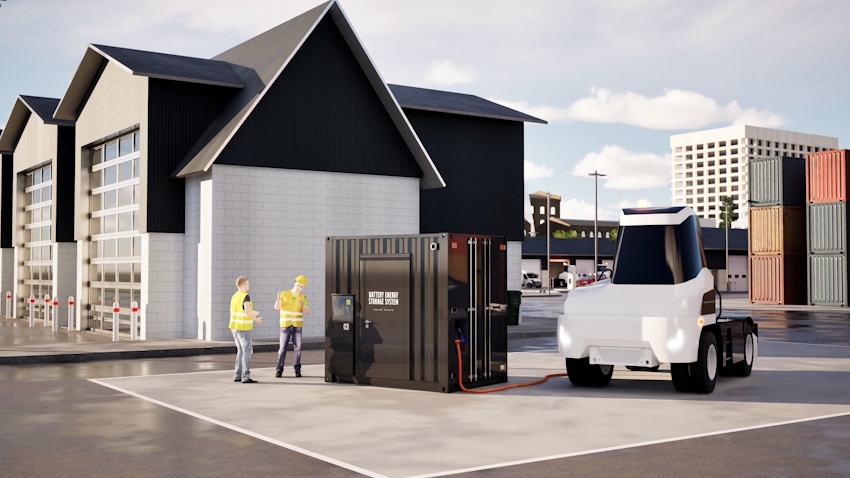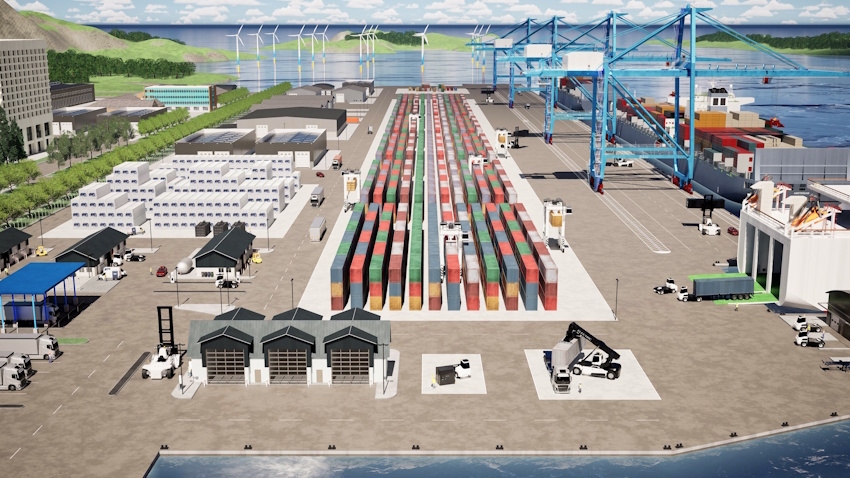Material-handling operations continue to transition toward electrification. With this movement, there are mounting challenges around grid capacity, peak demand, and the need for fast, reliable charging. Volvo Penta’s battery systems for energy storage are designed to help address these issues. Volvo Penta offers compact, energy-dense solutions that provide flexible and transportable power where it’s needed, from bustling warehouses to large-scale distribution hubs and port terminals.

Electric equipment is placing increasing demands on power infrastructure. Electric port equipment can have high energy demands that fluctuate throughout the day depending on intensity of operation. A battery energy storage system (BESS) helps manage and optimize how that energy is supplied, stored, and used when encountering:
- Sites with available grid power but insufficient capacity for fast charging or peak demand.
- Facilities expanding or upgrading fleets without corresponding increases in energy supply.
- Businesses in transition phases where grid upgrades are delayed or not yet secured.
Volvo Penta’s BESS subsystems assist in operators to bridge these gaps by delivering reliable, high-density energy, stabilizing grid fluctuations, and helping provide continuous uptime in mission-critical logistics operations.
Fast, flexible charging for electric fleets
With a favorable C-rate, Volvo Penta’s BESS subsystem supports rapid charging cycles and grid stability. This is particularly vital in 24/7 material-handling environments where downtime directly impacts throughput. Whether used to charge electric forklifts during peak shifts or to balance energy use in a port-side microgrid, the system provides dependable performance.
Easier deployment for dynamic operations
Highly transportable and compact, Volvo Penta’s BESS subsystems can be relocated across sites or terminals as energy demand evolves. For instance, ports around the world are accelerating efforts to reduce emissions by enabling ships to connect to onshore power or other zero-emission energy sources while at berth. Volvo Penta’s battery systems for energy storage are well positioned to support this transition. With a high C-rate, these systems deliver excellent energy density for mobile BESS set ups, allowing a large amount of installed energy to be carried within a compact configuration. This makes them ideal for use in mobile energy storage setups that can provide flexible charging to ships at dock.

What’s inside?
At the core of every subsystem is a Volvo Group-derived battery pack, rigorously tested for durability and backed by strong environmental protection ratings. Each unit includes:
- A Battery Management System (BMS) that optimizes performance, safety, and cybersecurity.
- A DC/DC converter for auxiliary power.
- Telematics for real-time monitoring and predictive maintenance.
- A robust thermal management system for consistent performance in diverse climates.
Each Volvo Penta subsystem covers the DC energy supply, while OEMs handle AC setup, container integration, and system configuration. This modular approach allows OEMs and system integrators to configure their turnkey BESS solutions and tailor to the specific needs of material-handling customers.
Ready for deployment
Volvo Penta offers integration-ready solutions to help the material-handling industry build a resilient and sustainable energy future. Visit the Volvo Penta website to find out more.
Volvo Penta, with approximately 3,500 dealers in over 130 countries, is a world-leading and global manufacturer of engines and complete power systems for boats, vessels and industrial applications. The engine program comprises diesel and gasoline engines with power outputs of between 10 and 1000 hp. Volvo Penta is part of the Volvo Group, one of the world’s leading manufacturers of heavy trucks, buses and construction equipment.
Connect with Volvo Penta on Facebook, LinkedIn, YouTube and Instagram for the latest company news and insight.
